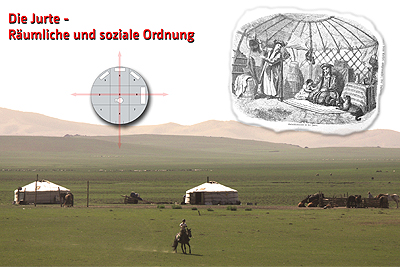
Die Jurte – Räumliche und soziale Ordnung
Ferenc Zámolyi
Das IVA – Institut für Vergleichende Architekturforschung lädt Sie herzlich zu folgendem Vortrag ein:
Zeit: 15.12.2012, 19:00 Uhr
Ort: Technische Universität Wien HS 6 Karlsplatz 13, 1040 Wien
This lecture examines and compares different perception of the house and its surroundings in nomadic and non-nomadic context. Not only the orientation and order within the house or yurt will be dealt with, but also dominant features of the landscape (mountains, rivers, etc) , which are used by nomads to delimit grazing territory or to orient themselves are discussed.
Although the exact way of formation of the lifestyle which we term „mobile Eurasian nomad” is still being debated, it can be assumed that it emerged from sedentary communities which gradually gave up their fixed homes and villages to move with their animals into the steppe area. This transformation took place on the meeting point of two different ecological zones, where supposedly both agriculture and animal husbandry were a viable option of subsistence. However, as one people ventured into the open steppes and more or less gradually gave up agriculture, some of their not so distant neighbors started to intensify their farming activities.
This development is also a crucial point in architectural development, where a clear transformation, at least in the sedentary communities can be witnessed: Former central house layouts are abandoned and clear longitudinal forms and compositions emerge, which reveal all basic characteristics of (speaking in Inner Asian context) later imperial Chinese architectural developments: Longitudinal buildings flanking atrium-like inner courtyards with colonnaded verandas, a strong axiality and an emphasis of disclosure of the building from the outer environment.
The way Mongolian and other steppe nomads have perceived their home, the yurt and the surrounding landscape is a fundamentally different from settled communities, for example in the Chinese imperial state. To this different perception different cosmologies are linked, which will be examined during the lecture.
Ferenc Zámolyi Geboren in Budapest. Architekturstudium an der Technischen Universität Wien. Seit 2004 Doktoratsstudium über „Traditionelle Architektur im Ostindonesischen Raum“. Feldforschungsaufenthalte in Indonesien, Ozeanien (Samoa, Fidschi) und Studienreisen nach Georgien, Ost-Türkei und Syrien. Gründungsmitglied des Instituts für Vergleichende Architekturforschung (IVA). Derzeit Projekte über Dokumentationvon traditionellen Architekturdenkmälern im mitteleuropäischen Raum (Österreich,Ungarn, Vojvodina).

